key BUICK REGAL 1994 User Guide
[x] Cancel search | Manufacturer: BUICK, Model Year: 1994, Model line: REGAL, Model: BUICK REGAL 1994Pages: 308, PDF Size: 15.78 MB
Page 80 of 308
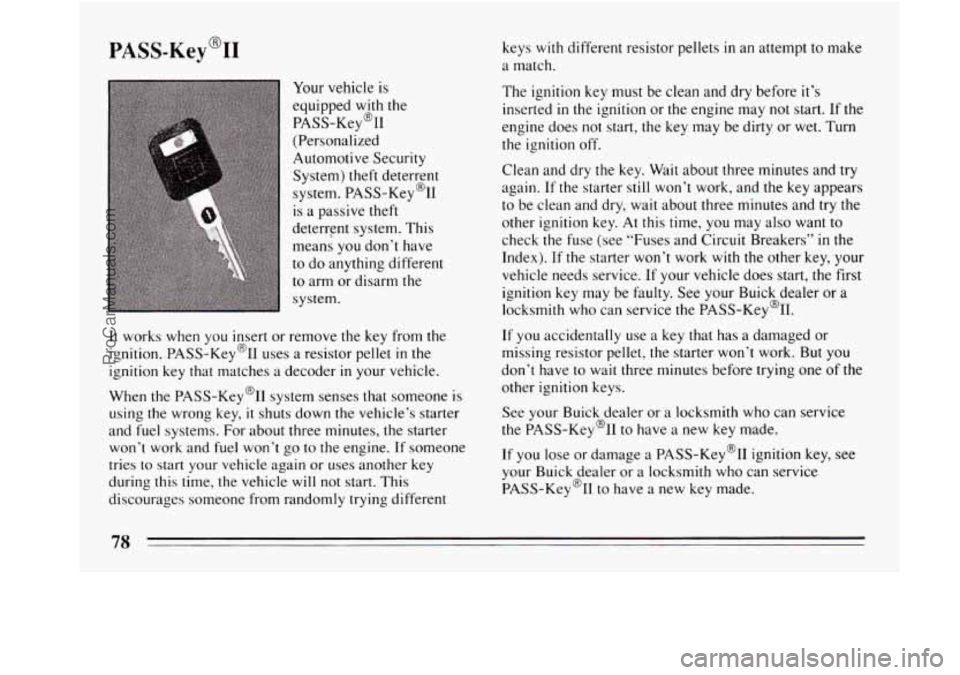
PASS-Key@II
Your vehicle is
equipped
with the
PASS-Key@II
(Personalized
Automotive Security
System) theft deterrent
system. PASS-Key(%
is a passive theft
deterrFnt system. This
means you don’t have
to do anything different
to arm or disarm the
system.
It works
when you insert or remove the key from the
ignition. PASS-Key% uses a resistor pellet
in the
ignition key that matches a decoder
in your vehicle.
When the PASS-Key% system senses that someone
is
using the wrong key, it shuts down the vehicle’s starter
and
fuel systems. For about three minutes, the starter
won’t work and fuel won’t
go to the engine. If someone
tries to start your vehicle again or uses another key
during this time, the vehicle will not start. This
discourages someone from randomly trying different keys
with different resistor pellets in an
attempt to make
a match.
The ignition key must be clean and dry before it’s
inserted
in the ignition or the engine may not start. If the
engine does not start, the key may be dirty or wet. Turn
the ignition off.
Clean and dry the key. Wait about three minutes and
try
again. If the starter still won’t work, and the key appears
to be clean and dry, wait about three minutes and try the
other ignition key. At this time, you may also want to
check the fuse (see “Fuses and Circuit Breakers’’
in the
Index). If the starter won’t work
with the other key, your
vehicle needs service. If your vehicle does start, the first
ignition key may be faulty. See your Buick dealer or a
locksmith who can service
the PASS-Key@II.
If you accidentally use
a key that has a damaged or
missing resistor pellet, the starter won’t work. But you
don’t have to wait three minutes before trying one of
the
other ignition keys.
See your Buick dealer or a locksmith who can service
the PASS-Key(% to have a new key made.
If you lose or damage a PASS-Key% ignition key, see
your Buick dealer or a locksmith who can service
PASS-Key@II to have a new key made.
78
ProCarManuals.com
Page 81 of 308
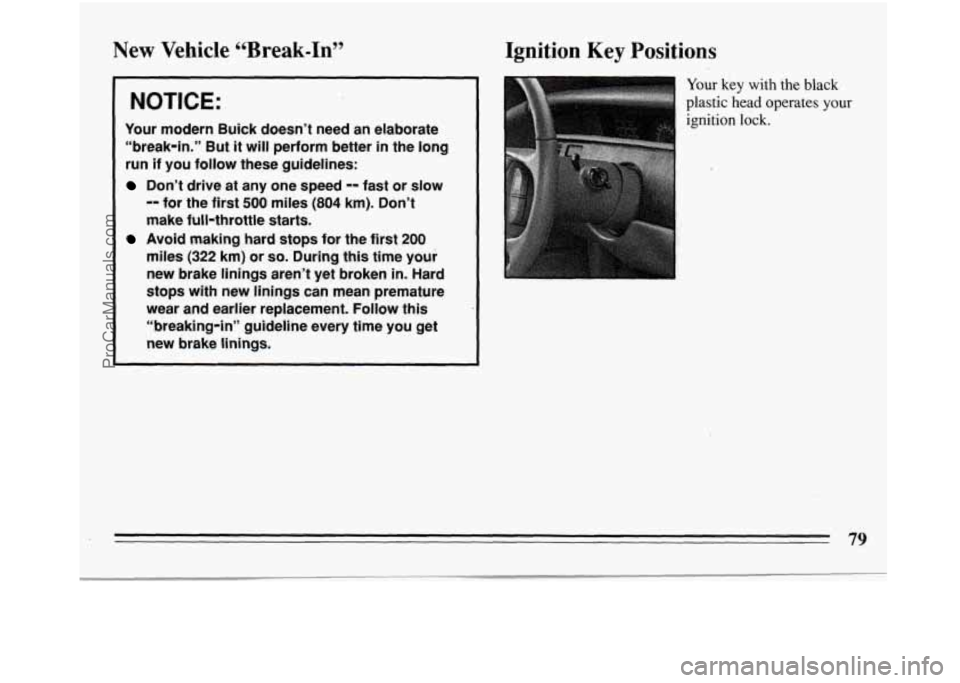
New Vehicle “Break-InSS
NOTICE:
Your modern Buick doesn’t need an elaborate
“break-in.” But it will perform better
in the long
run if you follow these guidelines:
Don’t drive at any one speed -- fast or slow
-- for the first 500 miles (804 km). Don’t
make full-throttle starts.
Avoid making hard stops for the first 200
miles (322 km) or so. During this time your
new brake linings aren’t yet broken
in. Hard
stops with new linings can mean premature
wear and earlier replacement. Follow this
“breaking-in” guideline every time you get
new brake linings.
Ignition Key Positions
Your key with the black
plastic
head operates your
ignition lock.
79
ProCarManuals.com
Page 82 of 308
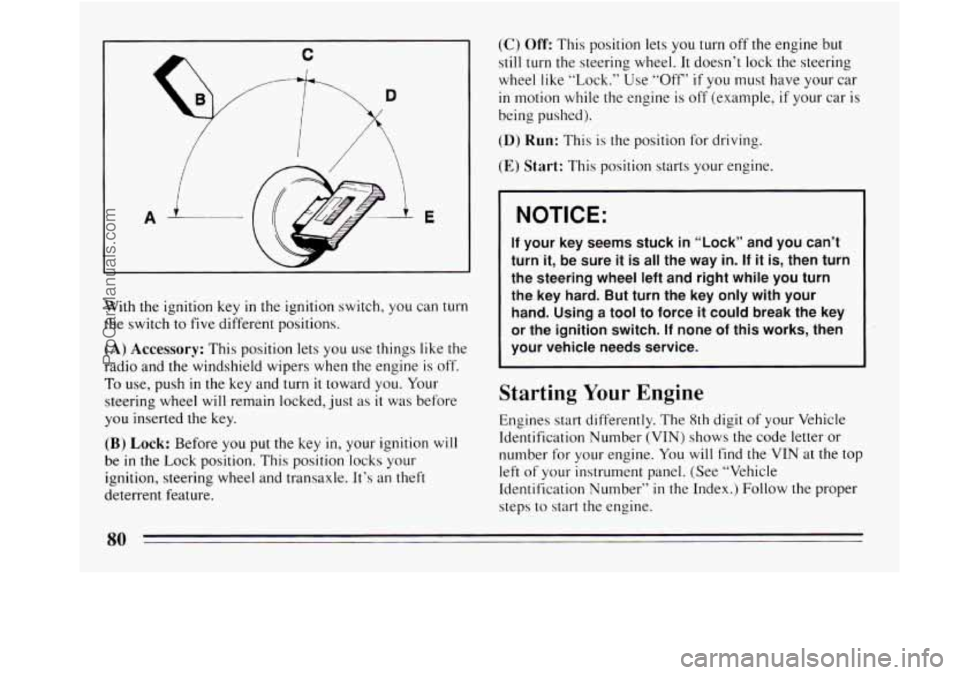
E
With the ignition key in the ignition switch, you can turn
the switch to five different positions.
(A) Accessory: This position lets you use things like the
radio and the windshield wipers when the engine is off.
To
use, push in the key and turn it toward you. Your
steering wheel
will remain locked, just as it was before
you inserted the key.
(B) Lock: Before you put the key in, your ignition will
be in the Lock position. This position locks your
ignition, steering wheel and transaxle. It’s an theft
deterrent feature.
(C) Off: This position lets you turn off the engine but
stili
turn the steering wheel. It doesn’t lock the steering
wheel like “Lock.” Use “Off’
if you must have your car
in motion while the engine is off (example, if your car is
being pushed).
(D) Run: This is the position for driving.
(E) Start: This position starts your engine.
I NOTICE:
If your key seems stuck in “Lock” and you can’t
turn’it, be sure
it is all the way in. If it is, then turn
the steering wheel left and right while you turn
the key hard. But turn the key only with your
hand. Using
a tool to force it could break the key
or the ignition switch. If none of this works, then
your vehicle needs service.
Starting Your Engine
Engines start differently. The 8th digit of your Vehicle
Identification Number (VIN) shows the code letter or
number for your engine. You will find the VIN at the top
left of your instrument panel. (See “Vehicle
Identification Number’’
in the Index.) Follow the proper
steps to start the engine.
80
ProCarManuals.com
Page 83 of 308

Move your shift lever to “P” (Park) or “N” (Neutral).
Your engine won’t start
in any other position -- that’s a
safety feature. To restart when you’re already moving,
use
“N” (Neutral) only.
NOTICE:
--
Don’t try to shift to “P” (Park) if your Buick is
moving. If you do, you could damage the
transaxle. Shift to “P” (Park) only when your
vehicle
is stopped.
To start your 3.1 Liter engine:
1. Without pushing the accelerator pedal, turn your
ignition key
to “Start.” When the engine starts, let go
of the key. The idle speed will go down as your
engine gets warm.
NOTICE:
Holding your key in “Start” for longer than 15
seconds at a time will cause your battery to be
drained much sooner. And the excessive heat
can damage your starter motor.
2. If your engine won’t start (or starts but then stops), it
could be flooded with too much gasoline. Try
pushing your accelerator pedal all the way to the
floor and holding
it there as you hold the key in
“Start” for about three seconds. If the car starts
briefly but then stops again, do the same thing, but
this time keep the pedal down for five or six seconds.
This clears the extra gasoline from the engine.
NOTICE:
Your engine is designed to work with the
electronics
in your vehicle. If you add electrical
parts
or accessories, you could change the way
the fuel injection system operates. Before adding
electrical equipment, check with your dealer. If
you don’t, your engine might not perform
properly.
If you ever have to have your vehicle towed, see
the part of this manual that tells how to do it
without damaging your vehicle. See “Towing
Your Car” in the Index.
81
ProCarManuals.com
Page 90 of 308
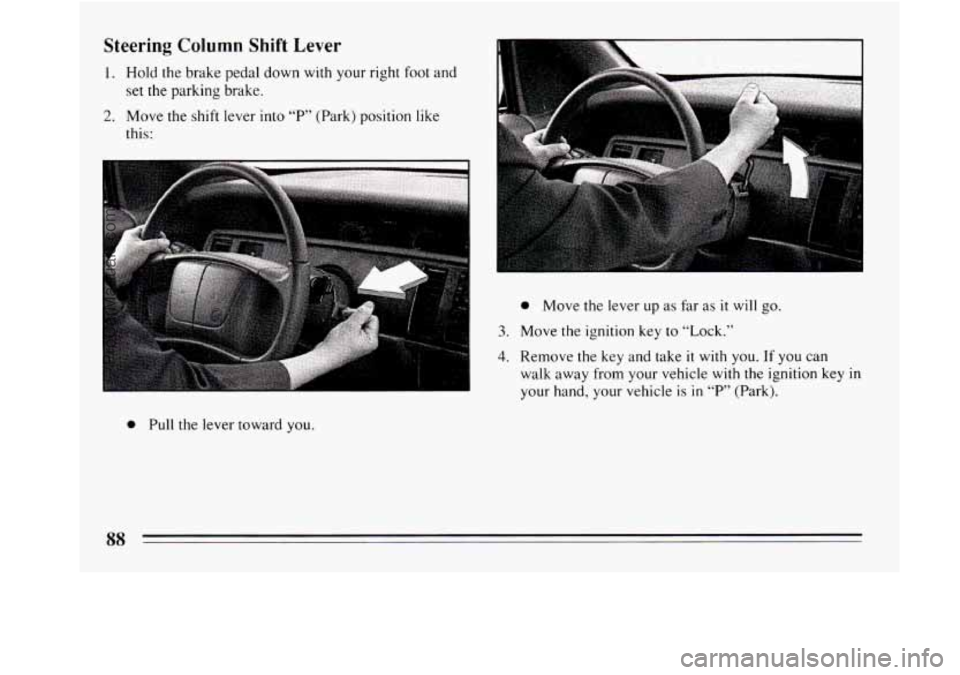
Steering Column Shift Lever
1. Hold the brake pedal down with your right foot and
set the parking brake.
2. Move the shift lever into “P” (Park) position like
this:
0 Pull the lever toward you.
0 Move the lever up as far as it will go.
3. Move the ignition key to “Lock.”
4. Remove the key and take it with you. If you can
walk away from your vehicle with the ignition key
in
your hand, your vehicle is in “P” (Park).
88
ProCarManuals.com
Page 91 of 308
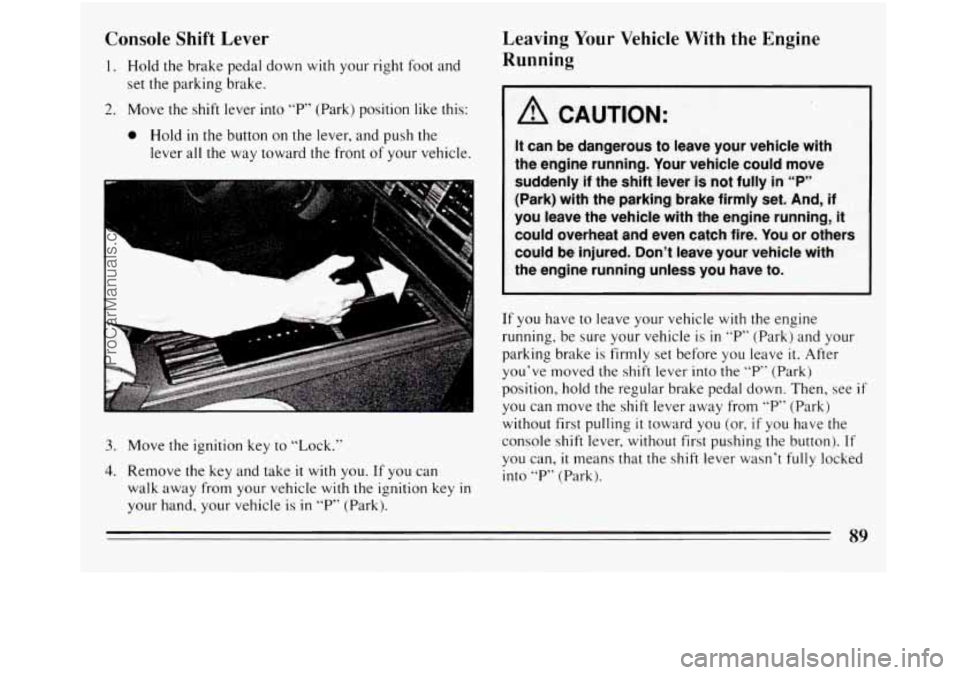
Console Shift Lever
set the parking brake.
1. Hold the brake pedal down with your right foot and
2. Move the shift lever into “P” (Park) position like this:
0 Hold in the button on the lever, and push the
lever all the way toward the front of your vehicle.
U
3. Move the ignition key to “Lock.”
4. Remove the key and take it with you. If you can
walk away from your vehicle
with the ignition key in
your hand, your vehicle is in “P” (Park).
Leaving Your Vehicle With the Engine
Running
1 A CAUTION:
If you have to leave your vehicle with the engine
running, be sure your vehicle
is in “P” (Park) and your
parking brake is firmly set before you leave
it. After
you’ve moved the shift lever into the
“P” (Park)
position, hold the regular brake pedal down. Then, see
if
you can move the shift lever away from “P” (Park)
without first pulling
it toward you (or, if you have the
console shift lever, without first pushing the button).
If
you can, it means that the shift lever wasn’t fully locked
into
“P” (Park).
89
ProCarManuals.com
Page 107 of 308

The reading lights on the inside rearview mirror are
turned on by pressing the switch.
Courtesy Lights
When any door is opened, several lights turn on. They
make
it easy for you to enter and leave the car. The
courtesy lights
go off when the doors are closed.
The interior courtesy lights can also be turned on by
moving the light switch to
INT. You can also change the
brightness of the instrument panel lights by moving the
switch between
OFF and DIM.
Illuminated Entry
Your courtesy lights will come on and stay on for a
predetermined time whenever you:
Open any door
Press the UNLOCK button on the Remote Keyless
Press the the power door UNLOCK switch.
If you open a door, the lights will stay on while it’s open
and then turn
off automatically about 16 seconds after
you close
it. They’ll shut off right away when you do
any of these things: ’
Turn the ignition key to Run or Start
Press the Power Door Lock switch
Press the DOOR button on the Remote Keyless
If you don’t open a door after pressing the UNLOCK
button on the Remote Keyless Entry or the power door
UNLOCK switch, the lights will turn off automatically
after about
16 seconds, or when you do any of the things
mentioned.
When the ignition is
on, pressing the UNLOCK button
on the Remote Keyless Entry or the power door
UNLOCK switch won’t activate
the Illuminated Entry.
Entry
(if equipped)
Entry
(if equipped).
105
ProCarManuals.com
Page 114 of 308

Your Buick has a “tamper-resistant odometer.” If you
can see very noticeable bright silver lines between the
numbers, probably someone has tried to turn
it back.
The numbers may not be true.
You may wonder what happens
if a car has to have a
new odometer installed. If possible, the new one has to
be set to
the same reading as the old one. If it can’t be,
then it’s set at zero, and a label on the driver’s door must
show the old reading and when the new one
was
installed.
Trip Odometer
A trip odometer can tell
you how many miles you
have driven since
you last
set
it back to zero. To reset
it, push the button.
Warning Lights, Gages and
Indicators
This section describes the warning lights and gages that
may be on your vehicle. The pictures will help you
locate them.
Warning lights and gages can signal that something is
wrong before
it becomes serious enough to cause an
expensive repair or replacement. Paying attention to
your warning lights and gages could
also save you or
others from injury.
Warning lights
go on when there may be or is a problem
with one of your vehicle’s functions. As you will see in
the details on the next few pages, some warning lights
come on briefly when you turn the ignition key
just to
let you know they’re working.
If you are familiar with
this section, you should not be alarmed
when this
happens.
Gages can indicate when there may be or is a problem
with one of your vehicle’s functions. Often gages and
warning lights work together to let
you know when
there’s a problem
with your vehicle.
112
ProCarManuals.com
Page 120 of 308

could be low on oil, or you might have some other oil
problem. Have your vehicle serviced as soon
as you can.
NOTICE:
Damage to your engine from neglected oil
problems can be costly and is not covered by
your warranty.
Low Oil Warning Light
LOW
OIL
Your vehicle is equipped
with an oil level monitoring
system. When the ignition
key is turned on, the light
will flash briefly.
If the light stays on, stop the vehicle on a level surface and
turn
off the engine. Check the oil level using the engine oil
dipstick. See “Engine Oil” in the Index. If the light does
not flash, have the low oil level sensor system repaired so
it will be ready to warn you if there’s a problem.
Note: The oil level monitoring system only checks oil
level during the brief period between key
on and engine
crank. It does not monitor engine oil level when the
engine
is running. Additionally, an oil level check is
only performed
if the engine has been turned off for a
considerable period of time allowing the oil normally
in
circulation to drain back into the oil pan.
118
ProCarManuals.com
Page 132 of 308
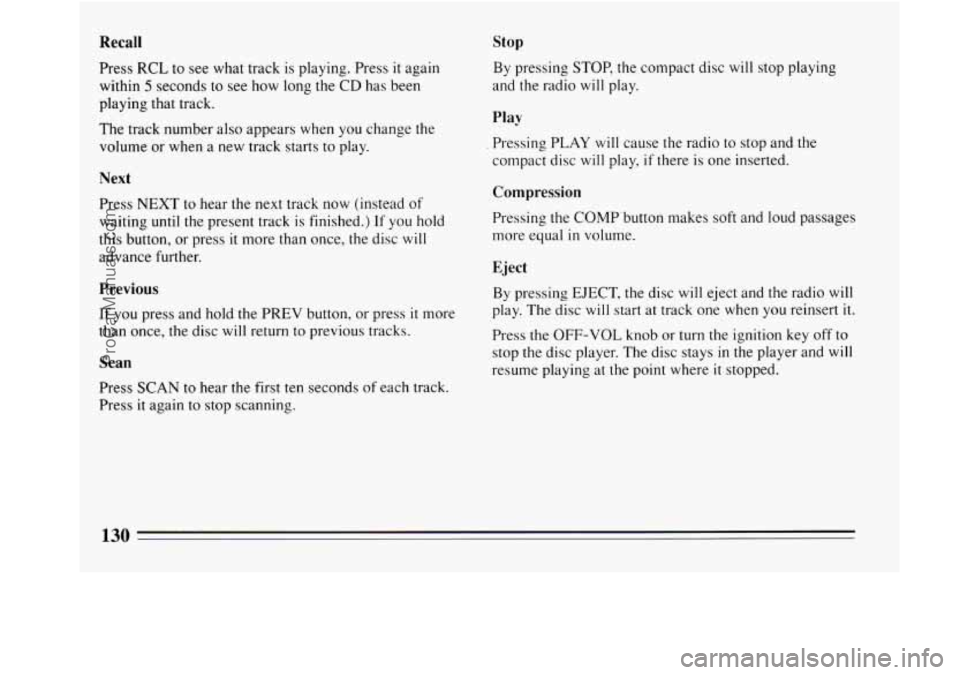
Recall
Press RCL to see what track is playing. Press it again
within
5 seconds to see how long the CD has been
playing that track.
The track number also appears when you change the
volume or when a new track starts to play.
Next
Press NEXT to hear the next track now (instead of
waiting until the present track is finished.)
If you hold
this button, or press it more than once, the disc
will
advance further.
Previous
If you press and hold the PREV button, or press it more
than once, the disc will return to previous tracks.
Scan
Press SCAN to hear the first ten seconds of each track.
Press it again to stop scanning.
stop
By pressing STOP, the compact disc will stop playing
and the radio
will play.
Play
compact disc will play, if there is one inserted.
. Pressing PLAY will cause the radio to stop and the
Compression
Pressing the COMP'button makes soft and loud passages
more equal
in volume.
Eject
By pressing EJECT, the disc will eject and the radio will
play. The disc will start at track one when you reinsert it.
Press the OFF-VOL knob or turn the ignition key off
to
stop the disc player. The disc stays in the player and will
resume playing at the point where
it stopped.
ProCarManuals.com